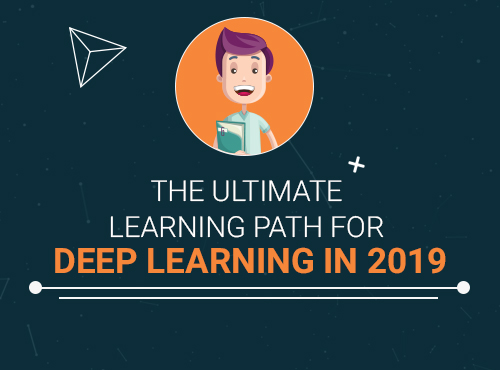The Learning Path for 2020 is now live! Head over here and start your deep learning journey.
Introduction
If there is one area in data science which has led to the growth of Machine Learning and Artificial Intelligence in the last few years, it is Deep Learning. From research labs in universities with low success in industry to powering every smart device on the planet – Deep Learning and Neural Networks have started a revolution.
Deep learning is ubiquitous – whether it’s Computer Vision applications or breakthroughs in the field of Natural Language Processing, we are living in a deep learning-fueled world.
Thanks to the rapid advances in technology, more and more people are able to leverage the power of deep learning. At the same time, it is a complex field and can appear daunting for newcomers.
With these things in mind, we are thrilled to launch a comprehensive learning path for deep learning in 2019! This learning path is filled with resources like books, courses and articles, and also has tests/quizzes to apply your freshly acquired knowledge.
But what truly differentiates our learning path from anything else out there is the structure we have put around this path. This essentially takes the confusion out of the entire learning process and let’s your focus on what matters – DEEP LEARNING!
Go ahead and access the most comprehensive learning path for deep learning to follow in 2019! You will need to register on the training portal which will also enable you to track your progress in each section.
Who is this Learning Path for?
This learning path has been designed for anyone who wants to learn Deep Learning, regardless of your level.
This structured path will be especially useful for folks looking to get straight to the action by learning through doing. Whether you are a complete fresher, or transitioning from a different field, or are looking to upskill yourself, this plan should give you the necessary direction.
If you plan to improve your existing deep learning skills or complement them with advanced concepts – this plan will guide you through that journey.
Summary – Learning Path for Deep Learning in 2019
Here is a high-level overview of the core concepts you should know (and master) in the deep learning sphere:
- Getting Started: Deep learning is a vast field made up of several components. So to kick off your learning journey, we recommend starting from the ground up. The first month will be all about understanding what deep learning means, covering basic descriptive statistics and probability concepts, and learning Python!
- Machine Learning Basics: The logical next step in our learning path takes you into the world of machine learning. This includes techniques like linear regression, logistic regression, and regularization methods. Deep learning cannot be truly grasped until you know the core concepts of linear algebra and calculus, so complement your skillset with an introduction to matrices, vectors and derivatives
- Introduction to Deep Learning and Keras: This is what you’ve been waiting for! March is when we recommend introducing yourself to neural networks. Additionally, you should start exploring the different frameworks in deep learning and start coding on one (our recommendation in this learning path is Keras). We have also provided a hands-on project to help you gain a practical understanding of these concepts
- Fine-Tuning your Neural Network: You’ve built your model and tested it out. What’s next? Models don’t usually give the best result in the first iteration, so knowing how to fine-tune and improve them is a critical skill any deep learning expert should know. Handling/preprocessing image data, understanding hyperparameter tuning and transfer learning, etc. are all a part of improving your deep learning model
- Understanding CNNs: Convolutional Neural Networks (CNNs) have become one of the most common use cases of deep learning in real-world scenarios. It is considered mandatory to know what CNNs are and how you can tune the internal hyperparameters to extract the maximum results out of them
- Debugging your Deep Learning Model: Ask any programmer, and they’ll tell you debugging is the least enjoyable part of their work. But how about the ability to visualize your deep learning model to understand where it’s going wrong? Yes, it’s now possible to analyze errors visually – a really cool and helpful skill we have highlighted in the learning path
- Sequence Models: This is where we really take a deep dive into deep learning. Sequence models include techniques like Recurrent Neural Networks (RNNs), Long Short Term Memory (LSTMs), and Gated Recurrent Unit (GRU). This is also the point where you should start differentiating yourself from the herd by applying these concepts on practical projects
- Deep Learning for NLP: Deep learning has changed the scope of NLP to a remarkable degree. With the flexibility of transfer learning, NLP has become a whole different beast. If this is your field of interest, we encourage you to stay on top of the game by learning the various methods of how deep learning can be used on text data. At the very least, an understanding of word embeddings will help immensely
- Unsupervised Deep Learning: Data scientists use a variety of algorithms to extract actionable insights. But the majority of these problems are of a supervised learning nature. Unsupervised learning is a challenging field, doubly so when it comes to deep learning. But it’s advantages are numerous and potentially ground-breaking. Hop on to this part of your learning path once you have a solid grasp on the above mentioned concepts
- GANs: One of my favorite deep learning concepts – Generative Adversarial Networks (GANs). They are behind all the creative AI developments we see regularly, including creating essays, writing poems, generating artwork, etc.
You can view and enroll in the deep learning path here.
Additionally, we have created a cool infographic to give you an idea of what to expect from the learning path, and to act as a checklist for your journey. It’s a month-by-month break down of what you should learn, and what skills/knowledge you should complement that monthly effort with (as shown in the white boxes below).






